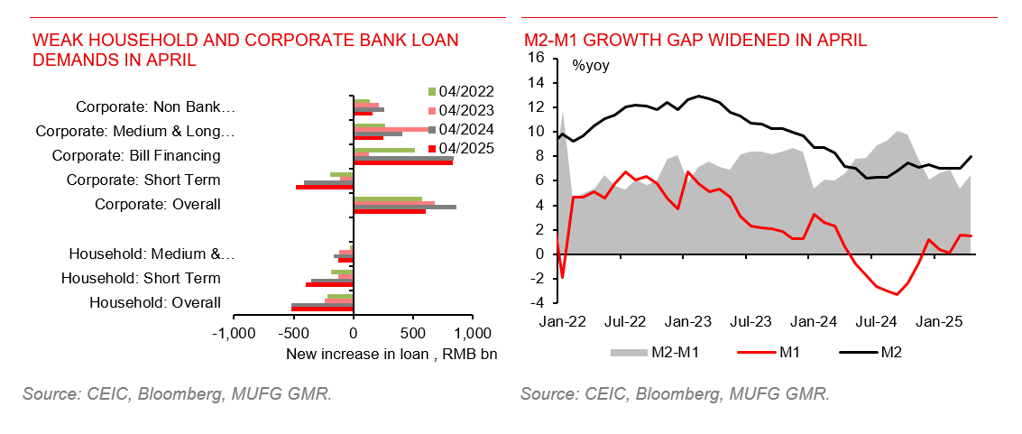Please download PDF using the link above for the full report
Key Points:
- April’s financial data indicates that fiscal expansion provided strong support for aggregate finance and broad money. However, the decline of loan growth amidst an accelerated growth of overall liquidity suggests a strong need to restore the endogenous financing demand.
- Given the 90-day truce of US-China trade war, we expect a modest 10bps policy rate cut by PBOC in remaining Q2 and PBOC to focus on implementing its 10-measure policies announced on 7 May.
Data event:
China released April’s financial data on 14 May. The new increase of aggregate financing in April was RMB 1,163bn, new bank loan was RMB 280bn. M1 growth slowed by 0.1ppts to 1.5%yoy in April, whereas M2 growth jumped by 1.0ppts to 8.0%yoy.
Comments:
Government bond issuance remained the driving force for the new increase of aggregate finance. Private demand for loan remained weak. With the CPI and PPI data being deflationary, the need to further reduce the real cost of funding is there. For the short term, further support for the economy shall come from the implementation of previously announced policies, e.g. policies rolled out on 7 May by both PBOC and NFRA.
- New increase in aggregate financing was RMB 1,163bn for April, and the growth of aggregate financing stock accelerated slightly by 0.3ppts to 8.7%yoy. The new increase of aggregate financing was mostly contributed by the net new government bond issuance (RMB 976bn). We see a further 1.5ppts growth pick-up of government bond stock to 20.9%yoy.
- There is an additional RMB 2.9 trillion worth of government bond issuance quota for this year. With the strong issuance in Jan-Apr, the pace of government bond issuance is likely to slow, weighting on the growth of overall aggregate financing ahead, if there is no additional quota of government bonds issuance announced.
- April’s loan data was a disappointment. New increased bank loan was only RMB 280bn in April, and loan stock growth slowed to 7.2%yoy from March’s 7.4%. Details show a more subdued new loan demand from corporates with the new increase less by RMB 250bn this April compared to same period a year ago. Household new loan demand remained quite depressed, with a new increase of RMB -522bn in April.
- Accelerated growths of deposit and M2 in April provide a big contrast with the decelerated loan growth. Deposit growth increased by 1.3ppts to 8.0% in April, and M2 growth improved by 1.0ppts to 8.0%yoy. M1 growth slowed by 0.1ppts to 1.5%yoy in April. As a result, the gap between M2 and M1 growths widened by 1.1ppts to 6.5%, implying a lower willingness to consume and invest against the backdrop of the escalated US-China trade war in the month.
- The weak demand was also implied by April’s CPI and PPI inflation prints as well. A -0.1%yoy was reported for April headline CPI inflation (0.1%mom in April), and PPI deflationary situation got even worse. PPI price index declined by 2.7%yoy in April, after March’s -2.5%yoy. On a sequential basis, PPI declined at the same pace as prior month at -0.4%mom.
- On 7 May, the PBoC announced monetary policy easing on various front, including a 10bps cut for 7-day reverse repo rate, cutting special structured instrument interest rates by 25bps; a 50bps RRR cut to unleash about RMB 1tn liquidity, lowering RRR for automobile financial and financial leasing companies from current 5% to 0% and etc.
We expect an additional 10bps cut in remaining Q2, for lowering the real cost of funding for stimulating economic activities. The focus of PBOC’s work in near term likely will be on implementing announced policies. On 7 May, PBOC announced 10-measures, including setting up a RMB 500bn relending quota for “service consumption and elderly care”, in an effort to guide the commercial banks to expand lending to the areas, a RMB 300bn quota increase for sci-tech innovation and tech transformation relending, a RMB 300bn quota increase for agricultural and small business-related relending.

